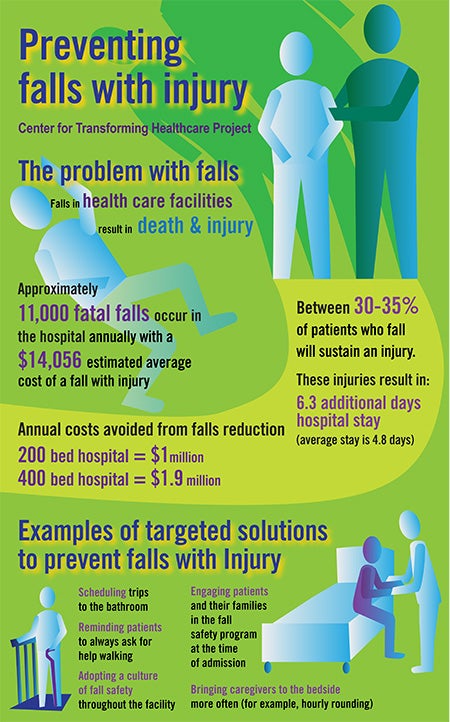Joint Commission targets solutions for fall prevention
 |
| The Joint Commission is developing a process to prevent the personal and financial costs related to patient falls. Infographic courtesy of the Joint Commission |
Preventing patient falls is an ongoing challenge for nearly all hospitals. The results of an 18-month project involving seven health care organizations may offer help to hospitals searching for solutions to this vexing problem.
The project, spearheaded by the Joint Commission Center for Transforming Healthcare, Oakbrook Terrace, Ill., resulted in a 62 percent reduction in falls that injured patients and a 35 percent drop in the rate of patient falls.
The Agency for Healthcare Research and Quality says that between 700,000 and 1 million patients fall in hospitals each year, according to a report in Hospitals & Health Networks magazine. Each year, approximately 11,000 falls result in a fatality, and between 30 and 35 percent of patients who fall are injured, center officials say.
Besides eliminating harm to patients, hospitals have a financial incentive to reduce falls. Patients who sustain an injury from a fall stay in the hospital an estimated six additional days beyond the average of five at a cost of about $14,000 to the hospital, according to the center.
By applying the fall-reduction strategies developed by the center, the number of patients injured in a fall at a typical 200-bed hospital could be reduced from 117 to 45 and save the facility about $1 million annually. A 400-bed hospital that reduced the number of patient falls with injury by 133 patients could expect to save $1.9 million annually, according to the center.
So, what's the key to curtailing falls? Erin DuPree, M.D., vice president and chief medical officer of the center, says the seven organizations that volunteered for the project utilized Robust Process Improvement (RPI). Developed by the center, the RPI methodology combines tools including Lean, Six Sigma and change management.
"It brings together the efficiencies gained with the Lean approach and the reduction in variation that comes from using Six Sigma and the all-important acceptance and accountability that comes through using the change management approach and tools," DuPree says.
It also became apparent during the project that the path to reducing falls varied at each participating organization and that there is no one-size-fits-all solution, she says. It's essential that each organization identify through the RPI what improvements are needed and how to fix them.
"What we find with these problems in health care is that they are very complex and that improvement is local. Each unit in each hospital has different reasons for why patients fall — there are different things that they need to target their solutions to," DuPree says. "This is more complicated than just doing A, B and C."
For example, solutions to eliminate patient falls that occur while using the bathroom include hourly rounding by nurses or implementing a regular schedule for patients at higher risk for falling.
DuPree emphasizes the importance of conducting a validated risk assessment for all patients. Also, it's essential that patients understand the importance of using a nurse call light to seek help when getting out of bed.
Another key solution is engaging all staff in the hospital about the importance of being on the alert for patients who are at risk of falling. "Preventing falls has typically been a nursing initiative or nursing project. More than anything, one of the key things to preventing falls is to know that it's everybody's job," DuPree says.
The center has developed a software application called the Targeted Solutions Tool that measures an organization's actual performance in the areas of hand hygiene, hand-off communications and wrong-site surgery. It is now developing a falls prevention aspect of the tool that hospitals are testing for validation, DuPree says.
The plan is to make the falls prevention tool available early in 2015 at no cost for Joint Commission-accredited hospitals and for a nominal fee for all other health care organizations, she adds.




